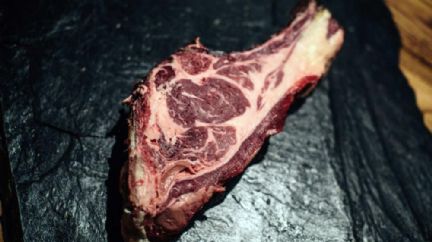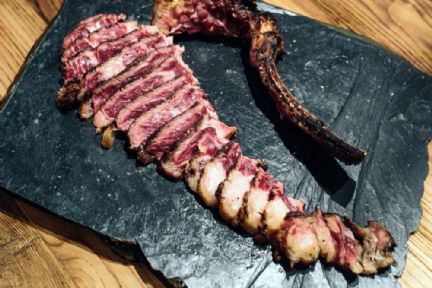| T O P I C R E V I E W |
| maryjane |
Posted - Dec 02 2016 : 11:40:57 AM
Author: Chloe Scott-Moncrieff
“We eat old and very fat cows,” says Basque butcher Imanol Jaca. He comes from a butcher shop in northwest Spain where age is revered, not reviled.
And if the exquisite fudgy steak known as txuleton produced by Jaca’s butchery is considered the holy grail of meat, then Jaca himself is the high priest.
A butcher by birth, trade, and devotion, the Spaniard exports his txuleton (pronounced “chu-le-ton”) steak across the world. And today, Jaca is in London, where he’ll be showing me the secrets to prepping this highly coveted meat.
.jpg?v 70000839)
All photos courtesy Sagardi
We meet at Sagardi, a Basque restaurant in East London. In the kitchen, a huge ox’s forerib sits on a butcher’s block, ready for Jaca to deconstruct into steaks. Sagardi co-founder Mikel Viñaspre will then prepare each one on the grill.
As Jaca gently pats the carpet of yellow fat nestling across the ox carcass, he explains: “There are no other countries who eat cow like us. Every week, I touch thousands of cow carcasses and I will know whether it’s good from just touching the fat.”
Txuleton doesn’t come from any old, farm-reared cow. Jaca sources his from either vaca (treasured former dairy cows) or buey (ox).
“For us, the most important thing is the cow is 12 to 20-years-old,” he says. “Why? Because this is the best flavour, it is long and strong.”
It’s not easy finding these cattle. The ox and working dairy cow have almost disappeared since tractors and mass milk exploitation replaced old fashioned subsistence farming practices in Spain. Jaca spends days wandering remote parts of Galicia and northern Portugal to track them down.
“The ox is generally with the farmer every day, so he eats well and lives like a king,” he explains. “But the dairy cow has the best fat.”
Either way, these bovine must be pampered and fed slowly over years by a loving farmer. Once slaughtered, the ox quarter must be brought to room temperature for at least two hours. The rest of the process isn’t so prescriptive.
“Some of this I can’t teach, it’s intuition, instinct,” explains Jaca. Rubbing his hands across the fat, he holds up his hands to show me. They’re glistening like he’s had some kind of new age pedicure. “The fat must come off when I rub. If the cow isn’t very fatty, it’s no good. I can smell grill, cheese, grass.”

All photos courtesy Sagardi
The aroma on Jaca’s hands reminds me of pata negra, the seductively good Spanish jamón that costs nearly £2,000 for a decent leg.
Finally, it’s time to slice. Using just a cleaver and a knife, Jaca cuts a neat horizontal line through the ox rib.
Viñaspre looks on with a mellow, blissed out gaze. He’s seen it all before but the theatre never ceases to thrill. He removes a slab and stipulates: “This bit we don’t like for txuleton, we call it tapa—flank—it will go in the stew.”
Jaca dismantles the rest of the meat in front of us. Teasing the steaks apart, his fingers move adeptly across the muscles. In seconds, he has a pile of 5 centimeter-thick slabs of meat. The flesh is chocolate brown and mottled with marbling.
Now, it’s Viñaspre’s turn. The artistry behind this Basque steak is also in its cooking.
“This is the grill,” he says. “It’s stainless steel, always very clean because we don’t want fire, we want strength from the charcoal, which must be top quality. We don’t want flavor from the charcoal on the steak.”
Salt is key to the txuleton, according to Viñaspre, who is as proud of his country’s food as Jaca. They use crusty, thick salt for cooking to seal the steak, while finer Ile de Re grains are sprinkled over for serving. It’s the antithesis of grilling a British or American steak. There’s hardly any flipping evident, as the meat is only turned once it is golden. “Salt should be added to the grilled, golden side, never the raw side—this would extract juices,” instructs Viñaspre.
The next few minutes are intense. Viñaspre waits for the inside fats and juices to “fuse” over the hot coals before moving them to a cooler grill area. We wait in huddles and sip our Basque cider anxiously. To wet our appetite, the kitchen has also prepared a soup of Tolosa black beans with morcilla. Like the ox, these beans are a delicacy of the Basque province of Gipuzkoa.

All photos courtesy Sagardi
But we’re all waiting for that showstopper: the ox.
Finally, the meat is ready. We stand in a ring around the table and dive in. The flavor is deeper and more intense than any steak I’ve tasted before and the fat is creamy and unctuous. These Basque beef shamans have led me on quite some trip.
From munchies.vice.com: http://bit.ly/2h3aU9j
|
| 4 L A T E S T R E P L I E S (Newest First) |
| hugho |
Posted - Dec 21 2017 : 07:32:37 AM
If you search for what cows they use it is apparent that they don't just take old Bossie. It seems they either use old oxen or take dairy cows who have been many years retired and put out to pasture for say 4 years and then slaughtered. THE OLD DAIRY COWS i SAW ON THE NET WERE SIZABLE, like maybe brown swiss size, not our lovely little Jerseys. One article described retiring dairy cows after only 4 years and pasturing them on grass for 4 years. Oh well so much for turning Bossie into a steak gold mine. |
| CloversMum |
Posted - Dec 16 2016 : 8:19:09 PM
Isn't it almost perfect that a very loved old dairy cow can give such a delicacy at the end? |
| farmlife |
Posted - Dec 05 2016 : 04:07:00 AM
Who knew old loved cows could turn into a delicacy? |
| NellieBelle |
Posted - Dec 04 2016 : 05:43:19 AM
Beef shamans for sure. Much knowledge and experience in the meat and preparation. It sounds divine. I'm sure anything I tried to procure from an old dairy cow, would taste like shoe leather. Thanks for sharing, really interesting material. |
|
|
![[flourish]](/images/flourish-txt_mobius.png)
![[flourish]](/images/flourish-txt_mobius.png)